Solar eclipse of November 19, 1816
Total eclipse From Wikipedia, the free encyclopedia
A total solar eclipse occurred at the Moon's descending node of orbit on Tuesday, November 19, 1816, with a magnitude of 1.0233. A solar eclipse occurs when the Moon passes between Earth and the Sun, thereby totally or partly obscuring the image of the Sun for a viewer on Earth. A total solar eclipse occurs when the Moon's apparent diameter is larger than the Sun's, blocking all direct sunlight, turning day into darkness. Totality occurs in a narrow path across Earth's surface, with the partial solar eclipse visible over a surrounding region thousands of kilometres wide. Occurring about 1.7 days before perigee (on November 17, 1816, at 17:10 UTC), the Moon's apparent diameter was larger.[1]
The path of totality was visible from parts of modern-day Norway, Sweden, Poland, western Ukraine, Romania, Turkey, Syria, Iraq, Iran, Afghanistan, Pakistan, northern India, and western China. A partial solar eclipse was also visible for parts of Europe, North Africa, Northeast Africa, the Middle East, Central Asia, and South Asia.
Observations
From Germany, this total eclipse could not be seen with clouded sky except by few observers at Pomerania only.[2]
Capel Lofft observed this eclipse from Ipswich.[3]
Eclipse details
Summarize
Perspective
Shown below are two tables displaying details about this particular solar eclipse. The first table outlines times at which the moon's penumbra or umbra attains the specific parameter, and the second table describes various other parameters pertaining to this eclipse.[4]
| Event | Time (UTC) |
|---|---|
| First Penumbral External Contact | 1816 November 19 at 08:01:46.3 UTC |
| First Umbral External Contact | 1816 November 19 at 09:20:18.4 UTC |
| First Central Line | 1816 November 19 at 09:21:02.3 UTC |
| First Umbral Internal Contact | 1816 November 19 at 09:21:46.7 UTC |
| Equatorial Conjunction | 1816 November 19 at 09:47:11.3 UTC |
| Ecliptic Conjunction | 1816 November 19 at 10:08:45.7 UTC |
| Greatest Eclipse | 1816 November 19 at 10:17:22.4 UTC |
| Greatest Duration | 1816 November 19 at 10:17:35.6 UTC |
| Last Umbral Internal Contact | 1816 November 19 at 11:13:19.6 UTC |
| Last Central Line | 1816 November 19 at 11:14:01.9 UTC |
| Last Umbral External Contact | 1816 November 19 at 11:14:43.9 UTC |
| Last Penumbral External Contact | 1816 November 19 at 12:33:14.9 UTC |
| Parameter | Value |
|---|---|
| Eclipse Magnitude | 1.02326 |
| Eclipse Obscuration | 1.04707 |
| Gamma | 0.84075 |
| Sun Right Ascension | 15h38m54.9s |
| Sun Declination | -19°30'48.2" |
| Sun Semi-Diameter | 16'11.7" |
| Sun Equatorial Horizontal Parallax | 08.9" |
| Moon Right Ascension | 15h40m03.9s |
| Moon Declination | -18°42'56.6" |
| Moon Semi-Diameter | 16'25.6" |
| Moon Equatorial Horizontal Parallax | 1°00'17.2" |
| ΔT | 12.2 s |
Eclipse season
This eclipse is part of an eclipse season, a period, roughly every six months, when eclipses occur. Only two (or occasionally three) eclipse seasons occur each year, and each season lasts about 35 days and repeats just short of six months (173 days) later; thus two full eclipse seasons always occur each year. Either two or three eclipses happen each eclipse season. In the sequence below, each eclipse is separated by a fortnight.
| November 19 Descending node (new moon) | December 4 Ascending node (full moon) |
|---|---|
 | |
| Total solar eclipse Solar Saros 120 | Partial lunar eclipse Lunar Saros 132 |
Related eclipses
Summarize
Perspective
Eclipses in 1816
- An annular solar eclipse on May 27.
- A total lunar eclipse on June 10.
- A total solar eclipse on November 19.
- A partial lunar eclipse on December 4.
Metonic
- Preceded by: Solar eclipse of February 1, 1813
- Followed by: Solar eclipse of September 7, 1820
Tzolkinex
- Preceded by: Solar eclipse of October 9, 1809
- Followed by: Solar eclipse of January 1, 1824
Half-Saros
- Preceded by: Lunar eclipse of November 15, 1807
- Followed by: Lunar eclipse of November 25, 1825
Tritos
- Preceded by: Solar eclipse of December 21, 1805
- Followed by: Solar eclipse of October 20, 1827
Solar Saros 120
- Preceded by: Solar eclipse of November 8, 1798
- Followed by: Solar eclipse of November 30, 1834
Inex
- Preceded by: Solar eclipse of December 9, 1787
- Followed by: Solar eclipse of October 30, 1845
Triad
- Preceded by: Solar eclipse of January 18, 1730
- Followed by: Solar eclipse of September 21, 1903
Solar eclipses of 1816–1819
This eclipse is a member of a semester series. An eclipse in a semester series of solar eclipses repeats approximately every 177 days and 4 hours (a semester) at alternating nodes of the Moon's orbit.[5]
The partial solar eclipses on March 25, 1819 and September 19, 1819 occur in the next lunar year eclipse set.
| Solar eclipse series sets from 1816 to 1819 | ||||||
|---|---|---|---|---|---|---|
| Ascending node | Descending node | |||||
| Saros | Map | Gamma | Saros | Map | Gamma | |
| 115 | May 27, 1816 Annular |
−0.9492 | 120 | November 19, 1816 Total |
0.8408 | |
| 125 | May 16, 1817 Annular |
−0.2049 | 130 | November 9, 1817 Total |
0.1487 | |
| 135 | May 5, 1818 Annular |
0.5440 | 140 | October 29, 1818 Total |
−0.5524 | |
| 145 | April 24, 1819 Partial |
1.2579 | 150 | October 19, 1819 Partial |
−1.3226 | |
Saros 120
This eclipse is a part of Saros series 120, repeating every 18 years, 11 days, and containing 71 events. The series started with a partial solar eclipse on May 27, 933 AD. It contains annular eclipses from August 11, 1059 through April 26, 1492; hybrid eclipses from May 8, 1510 through June 8, 1564; and total eclipses from June 20, 1582 through March 30, 2033. The series ends at member 71 as a partial eclipse on July 7, 2195. Its eclipses are tabulated in three columns; every third eclipse in the same column is one exeligmos apart, so they all cast shadows over approximately the same parts of the Earth.
The longest duration of annularity was produced by member 11 at 6 minutes, 24 seconds on September 11, 1113, and the longest duration of totality was produced by member 60 at 2 minutes, 50 seconds on March 9, 1997. All eclipses in this series occur at the Moon’s descending node of orbit.[6]
| Series members 50–71 occur between 1801 and 2195: | ||
|---|---|---|
| 50 | 51 | 52 |
 November 19, 1816 |
 November 30, 1834 |
 December 11, 1852 |
| 53 | 54 | 55 |
 December 22, 1870 |
 January 1, 1889 |
 January 14, 1907 |
| 56 | 57 | 58 |
 January 24, 1925 |
 February 4, 1943 |
 February 15, 1961 |
| 59 | 60 | 61 |
 February 26, 1979 |
 March 9, 1997 |
 March 20, 2015 |
| 62 | 63 | 64 |
 March 30, 2033 |
 April 11, 2051 |
 April 21, 2069 |
| 65 | 66 | 67 |
 May 2, 2087 |
 May 14, 2105 |
 May 25, 2123 |
| 68 | 69 | 70 |
 June 4, 2141 |
 June 16, 2159 |
 June 26, 2177 |
| 71 | ||
 July 7, 2195 | ||
Metonic series
The metonic series repeats eclipses every 19 years (6939.69 days), lasting about 5 cycles. Eclipses occur in nearly the same calendar date. In addition, the octon subseries repeats 1/5 of that or every 3.8 years (1387.94 days). All eclipses in this table occur at the Moon's descending node.
| 22 eclipse events between September 8, 1801 and September 7, 1877 | ||||
|---|---|---|---|---|
| September 7–8 | June 26–27 | April 14–15 | January 31–February 1 | November 19–20 |
| 112 | 114 | 116 | 118 | 120 |
 September 8, 1801 |
 June 26, 1805 |
 April 14, 1809 |
 February 1, 1813 |
 November 19, 1816 |
| 122 | 124 | 126 | 128 | 130 |
 September 7, 1820 |
 June 26, 1824 |
 April 14, 1828 |
 February 1, 1832 |
 November 20, 1835 |
| 132 | 134 | 136 | 138 | 140 |
 September 7, 1839 |
 June 27, 1843 |
 April 15, 1847 |
 February 1, 1851 |
 November 20, 1854 |
| 142 | 144 | 146 | 148 | 150 |
 September 7, 1858 |
 June 27, 1862 |
 April 15, 1866 |
 January 31, 1870 |
 November 20, 1873 |
| 152 | ||||
 September 7, 1877 | ||||
Tritos series
This eclipse is a part of a tritos cycle, repeating at alternating nodes every 135 synodic months (≈ 3986.63 days, or 11 years minus 1 month). Their appearance and longitude are irregular due to a lack of synchronization with the anomalistic month (period of perigee), but groupings of 3 tritos cycles (≈ 33 years minus 3 months) come close (≈ 434.044 anomalistic months), so eclipses are similar in these groupings.
| Series members between 1801 and 2200 | ||||
|---|---|---|---|---|
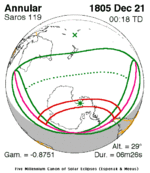 December 21, 1805 (Saros 119) |
 November 19, 1816 (Saros 120) |
 October 20, 1827 (Saros 121) |
 September 18, 1838 (Saros 122) |
 August 18, 1849 (Saros 123) |
 July 18, 1860 (Saros 124) |
 June 18, 1871 (Saros 125) |
 May 17, 1882 (Saros 126) |
 April 16, 1893 (Saros 127) |
 March 17, 1904 (Saros 128) |
 February 14, 1915 (Saros 129) |
 January 14, 1926 (Saros 130) |
 December 13, 1936 (Saros 131) |
 November 12, 1947 (Saros 132) |
 October 12, 1958 (Saros 133) |
 September 11, 1969 (Saros 134) |
 August 10, 1980 (Saros 135) |
 July 11, 1991 (Saros 136) |
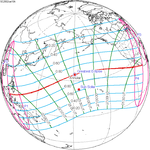 June 10, 2002 (Saros 137) |
 May 10, 2013 (Saros 138) |
 April 8, 2024 (Saros 139) |
 March 9, 2035 (Saros 140) |
 February 5, 2046 (Saros 141) |
 January 5, 2057 (Saros 142) |
 December 6, 2067 (Saros 143) |
 November 4, 2078 (Saros 144) |
 October 4, 2089 (Saros 145) |
 September 4, 2100 (Saros 146) |
 August 4, 2111 (Saros 147) |
 July 4, 2122 (Saros 148) |
 June 3, 2133 (Saros 149) |
 May 3, 2144 (Saros 150) |
 April 2, 2155 (Saros 151) |
 March 2, 2166 (Saros 152) |
 January 29, 2177 (Saros 153) |
 December 29, 2187 (Saros 154) |
 November 28, 2198 (Saros 155) | |||
Inex series
This eclipse is a part of the long period inex cycle, repeating at alternating nodes, every 358 synodic months (≈ 10,571.95 days, or 29 years minus 20 days). Their appearance and longitude are irregular due to a lack of synchronization with the anomalistic month (period of perigee). However, groupings of 3 inex cycles (≈ 87 years minus 2 months) comes close (≈ 1,151.02 anomalistic months), so eclipses are similar in these groupings.
| Series members between 1801 and 2200 | ||
|---|---|---|
 November 19, 1816 (Saros 120) |
 October 30, 1845 (Saros 121) |
 October 10, 1874 (Saros 122) |
 September 21, 1903 (Saros 123) |
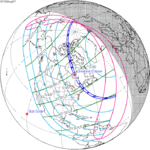 August 31, 1932 (Saros 124) |
 August 11, 1961 (Saros 125) |
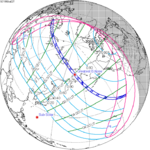 July 22, 1990 (Saros 126) |
 July 2, 2019 (Saros 127) |
 June 11, 2048 (Saros 128) |
 May 22, 2077 (Saros 129) |
 May 3, 2106 (Saros 130) |
 April 13, 2135 (Saros 131) |
 March 23, 2164 (Saros 132) |
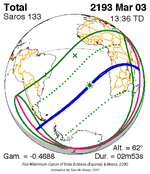 March 3, 2193 (Saros 133) |
|
Notes
References
Wikiwand - on
Seamless Wikipedia browsing. On steroids.

